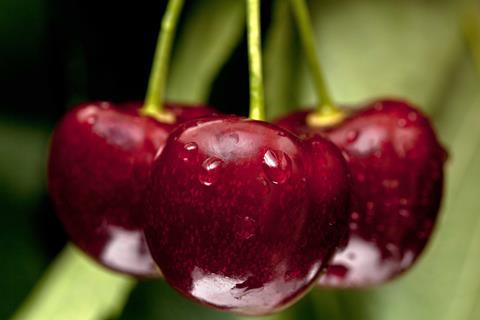
After a nearly seven-year inter-governmental process, British Columbian-grown cherries just secured official access to the lucrative Chinese mainland market. Despite the excitement within the industry, however, grower-shippers say they will be treading very carefully in this first year of access.
David Geen, director of the British Columbian (BC) Cherry Association’s market access group and owner of leading exporter Jealous Fruits, told Asiafruit that this debut season would be treated as a trial and volumes would be limited, with a view to ramping up shipments in 2014.
One of the reasons for the caution is China’s verification of the protocol procedures.
The protocol basically involves a ‘systems approach’ to managing pest risks, with trapping at orchard level, a rigorous spray programme and holding mature fruit for a 10-day incubation period.
Sweeter deal without cold treatment
China’s primary pest of concern is Western Cherry Fruit Fly, and its quarantine authorities had originally insisted on a cold treatment protocol in addition to the systems approach at the end of last season.
But Canada’s plant quarantine department have since convinced China that Western Cherry Fruit Fly is a temperate pest and not necessarily vulnerable to cold treatment – unlike Mediterranean fruit fly, which is tropical in nature and not present in Canada.
Canada’s Food Inspection Agency has long used a brown sugar solution to test fruit for the presence of Western Cherry Fruit Fly, according to Christine Dendy, chairperson of the BC Cherry Association.
Under this process, samples of the fruit are crushed and immersed in water with a high concentration of brown sugar for around 10 minutes to determine whether any larvae are present. China has agreed to this system pending confirmation of its reliability with a concurrent 10-day sample incubation test.
“The brown sugar solution has been proven over the years to be an effective way of detecting the presence of Western Cherry Fruit Fly,” Dendy told Asiafruit. “We don’t have Med-fly here and the science doesn’t really support cold treatment for Western Cherry Fruit Fly. We run a full control programme regardless of the testing, but the Chinese want to double-check the validity of the testing.”
If grower-packers had to cold-treat their fruit, it would negate any advantage to shipping fruit by air, so securing a cold treatment-free protocol is key to capitalising on the market potential with fresh air-flown fruit.
Logistical challenge for inspectors
Chinese inspectors are not due to arrive in Canada until 25 July, which should allow the industry to start sending some fruit in late July/early August, according to Dendy.
Dendy added that there would be some logistical hurdles to overcome in the inspection process. “The inspectors want to look at all shipments; that will be fairly time consuming and will limit the volume we can send as there are around 20 packhouses spread over 200km across the [Okanagan] Valley,” she said.
The industry is also eager to ensure there are no mistakes with the protocol this year, according to Geen, thereby paving the way to ramp up volumes in 2014.
The late show
While the Canadian cherry industry is a fraction of the size of Washington’s, it is growing at a healthy clip. Geen estimates that BC has around 4,000 acres planted, and a significant percentage of these are not bearing yet.
According to Andre Bailey of Global Fruit Brokers, BC is currently producing approximately 2m cartons (9.1 kg) annually. With the new orchards coming into production, it is estimated that BC could pack as much as 2.5m cartons within five years.
Canadian cherries have already carved out a presence in Asia, particularly Taiwan, Hong Kong and South East Asia, aided by their high-quality and late availability. The British Columbian season extends beyond the US Northwest cherry deal, allowing shippers to supply demand for key periods such as the Moon Festival and National Day Holiday celebrated in China.
“We’re very pleased as an industry to have secured access to China,” said Dendy, “because we see this as a pretty bi market opportunity. Canadian cherries are generally large and firm, and we’re fairly late, which is really good if people want cherries for those festivals. This deal puts us in reach.”
Chinese buyers see bright future
Chinese importers are also enthused about the prospects for Canadian cherries.
“The fact the Canadian cherries can now come direct to China, and into major cities such as Shanghai and Beijing, is excellent news,” Owen Ou of Dalian Yidu told Asiafruit. “We see very good opportunities for them in China. They’re later than American and local cherries, they’re available for the Moon Festival, and their quality is near perfect. Their only real problem is there is not enough volume and there aren’t many big companies in their industry.”
Kurt Huang of Shanghai Longwu Wholesale Market said that access for Canadian cherries had been long anticipated by both sides – and that the perception of the fruit among importers/wholesalers was generally positive.
“The prices of early season fruit might be restrained by the presence of Washington fruit on the market, but the late harvest fruit should have a good chance of securing high returns, especially fruit that arrives by sea in September.”
BC blueberries eye breakthrough
In addition to the access for British Columbian cherries, negotiations are progressing to open the Chinese market to the province’s blueberries in 2014. That signals another potentially lucrative market for the industry, given the pace at which demand for blueberries is growing in China.
While stating that Canadian blueberries “had a chance” in the Chinese market, Huang pointed out that a high import duty of 46.9 per cent would keep the costs high. “The duty on Chilean blueberries is 19.78 per cent in 2013, but that’ll come down each year, falling to 16.39 per cent next year and 13 per cent in 2015.”



